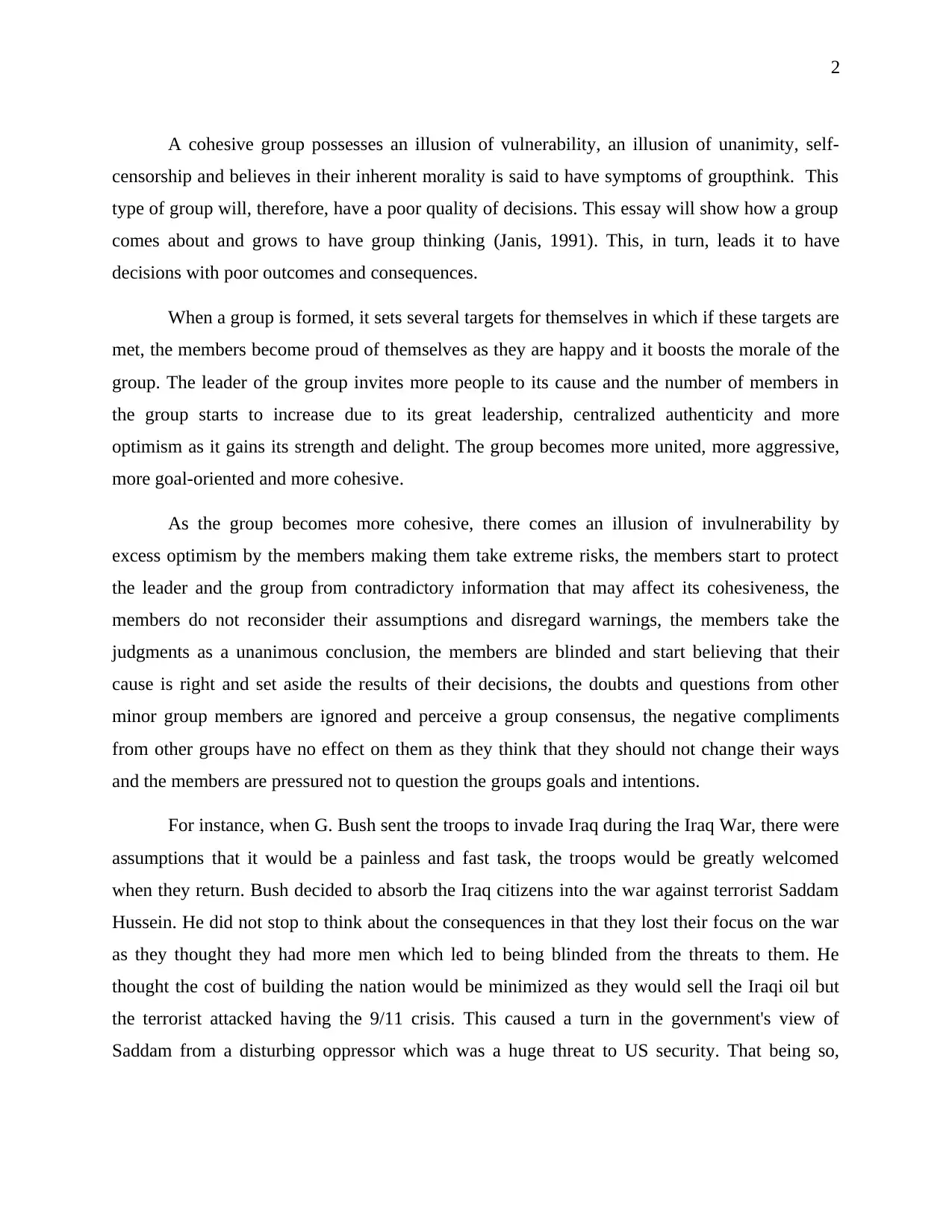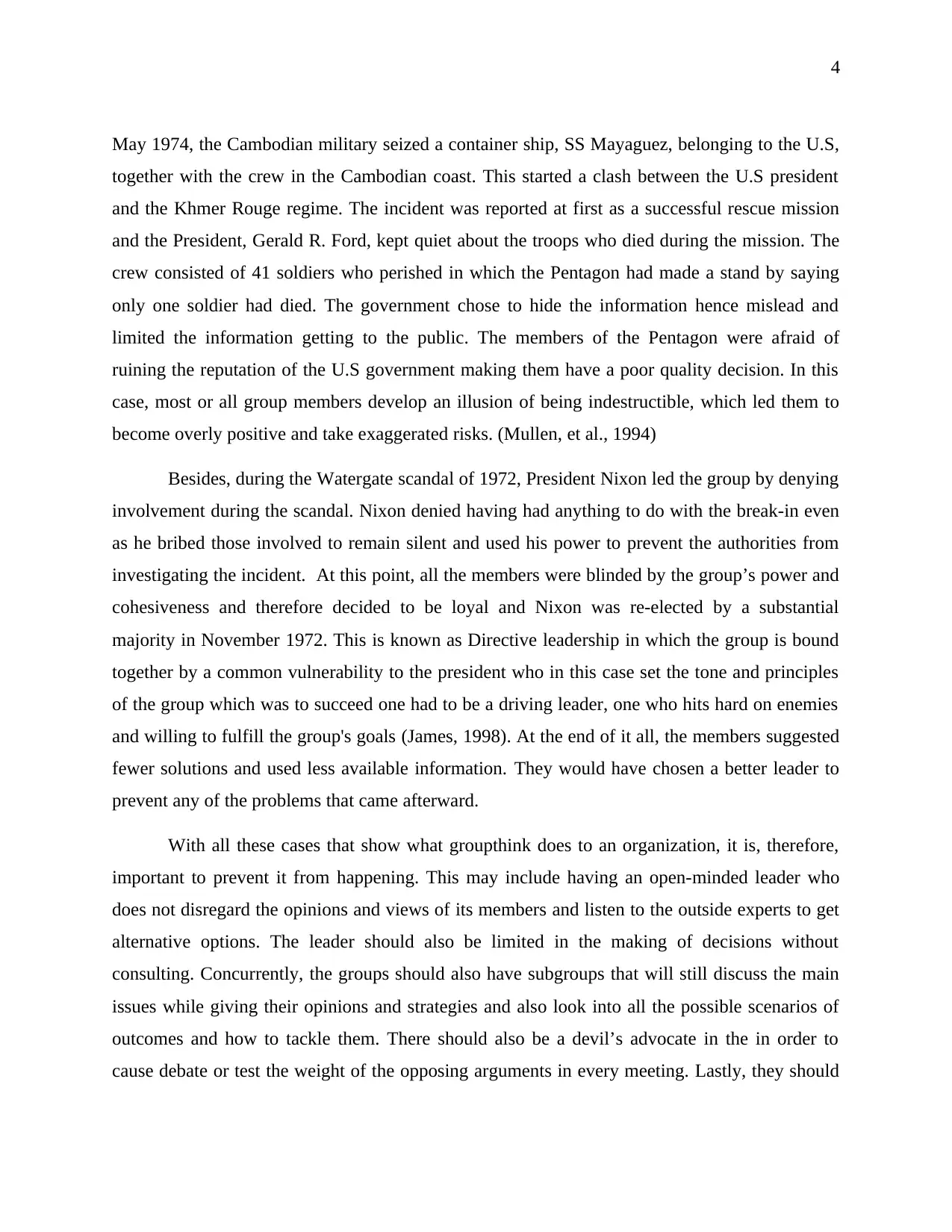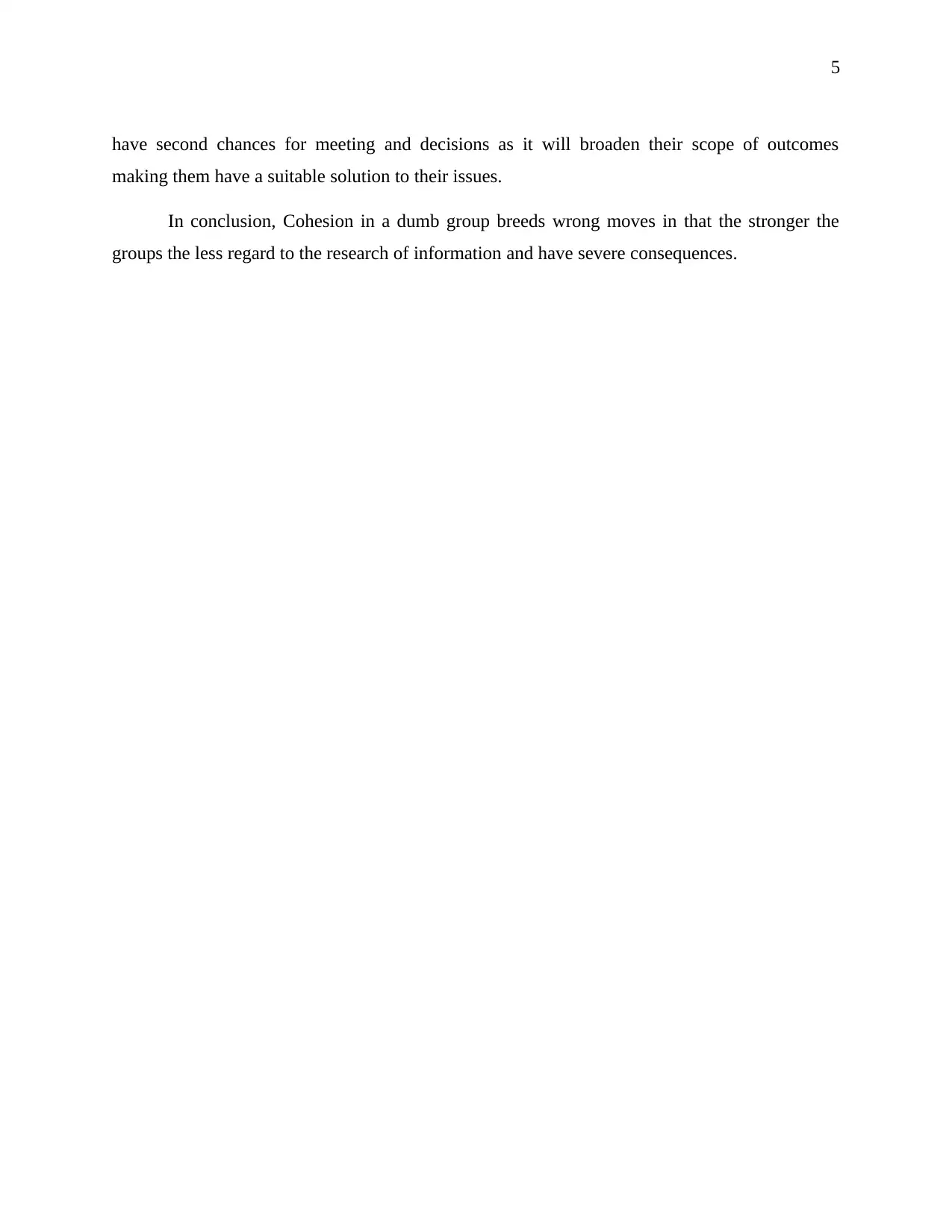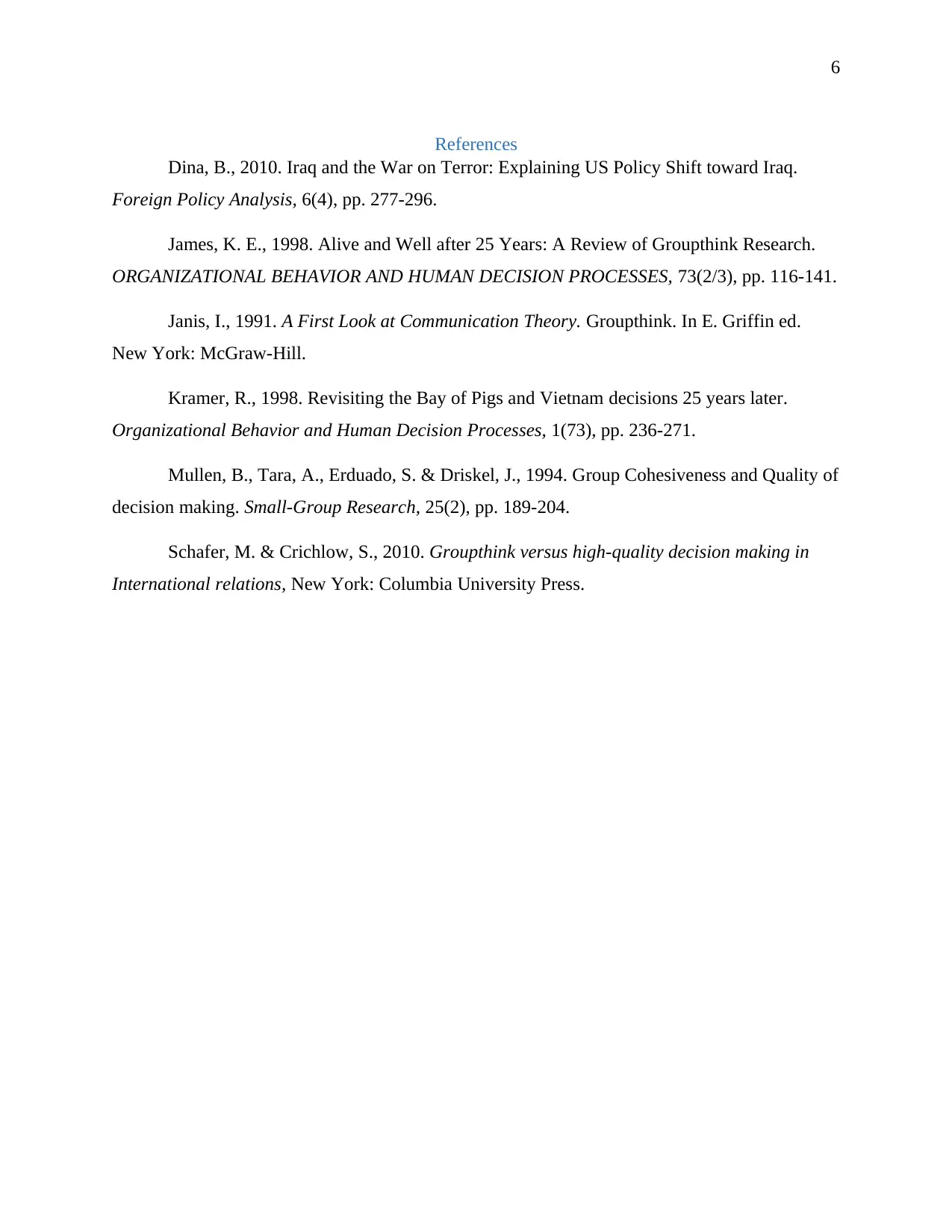CSC3501 - Group Cohesion and its Detrimental Effect on Decisions
VerifiedAdded on 2023/03/30
|6
|1501
|315
Essay
AI Summary
This essay examines the phenomenon of groupthink, where excessive group cohesion leads to flawed decision-making processes. It discusses how groups, initially formed with positive intentions and strong leadership, can develop an illusion of invulnerability, suppress dissenting opinions, and ultimately make poor judgments. The essay cites historical examples such as the Iraq War, the Challenger space shuttle disaster, the Bay of Pigs invasion, the Mayaguez incident, and the Watergate scandal to illustrate the detrimental effects of groupthink. It further explores concepts like group polarization and group efficacy as contributing factors. The essay concludes by suggesting strategies to prevent groupthink, including promoting open-minded leadership, encouraging diverse opinions, and conducting thorough risk assessments. Desklib offers a range of resources, including solved assignments and past papers, to aid students in understanding similar concepts.

1
Cohesion in a dumb group breeds wrong moves.
By (Name)
Name of Class
Professor
Name of School
City located
Date
Cohesion in a dumb group breeds wrong moves.
By (Name)
Name of Class
Professor
Name of School
City located
Date
Paraphrase This Document
Need a fresh take? Get an instant paraphrase of this document with our AI Paraphraser

2
A cohesive group possesses an illusion of vulnerability, an illusion of unanimity, self-
censorship and believes in their inherent morality is said to have symptoms of groupthink. This
type of group will, therefore, have a poor quality of decisions. This essay will show how a group
comes about and grows to have group thinking (Janis, 1991). This, in turn, leads it to have
decisions with poor outcomes and consequences.
When a group is formed, it sets several targets for themselves in which if these targets are
met, the members become proud of themselves as they are happy and it boosts the morale of the
group. The leader of the group invites more people to its cause and the number of members in
the group starts to increase due to its great leadership, centralized authenticity and more
optimism as it gains its strength and delight. The group becomes more united, more aggressive,
more goal-oriented and more cohesive.
As the group becomes more cohesive, there comes an illusion of invulnerability by
excess optimism by the members making them take extreme risks, the members start to protect
the leader and the group from contradictory information that may affect its cohesiveness, the
members do not reconsider their assumptions and disregard warnings, the members take the
judgments as a unanimous conclusion, the members are blinded and start believing that their
cause is right and set aside the results of their decisions, the doubts and questions from other
minor group members are ignored and perceive a group consensus, the negative compliments
from other groups have no effect on them as they think that they should not change their ways
and the members are pressured not to question the groups goals and intentions.
For instance, when G. Bush sent the troops to invade Iraq during the Iraq War, there were
assumptions that it would be a painless and fast task, the troops would be greatly welcomed
when they return. Bush decided to absorb the Iraq citizens into the war against terrorist Saddam
Hussein. He did not stop to think about the consequences in that they lost their focus on the war
as they thought they had more men which led to being blinded from the threats to them. He
thought the cost of building the nation would be minimized as they would sell the Iraqi oil but
the terrorist attacked having the 9/11 crisis. This caused a turn in the government's view of
Saddam from a disturbing oppressor which was a huge threat to US security. That being so,
A cohesive group possesses an illusion of vulnerability, an illusion of unanimity, self-
censorship and believes in their inherent morality is said to have symptoms of groupthink. This
type of group will, therefore, have a poor quality of decisions. This essay will show how a group
comes about and grows to have group thinking (Janis, 1991). This, in turn, leads it to have
decisions with poor outcomes and consequences.
When a group is formed, it sets several targets for themselves in which if these targets are
met, the members become proud of themselves as they are happy and it boosts the morale of the
group. The leader of the group invites more people to its cause and the number of members in
the group starts to increase due to its great leadership, centralized authenticity and more
optimism as it gains its strength and delight. The group becomes more united, more aggressive,
more goal-oriented and more cohesive.
As the group becomes more cohesive, there comes an illusion of invulnerability by
excess optimism by the members making them take extreme risks, the members start to protect
the leader and the group from contradictory information that may affect its cohesiveness, the
members do not reconsider their assumptions and disregard warnings, the members take the
judgments as a unanimous conclusion, the members are blinded and start believing that their
cause is right and set aside the results of their decisions, the doubts and questions from other
minor group members are ignored and perceive a group consensus, the negative compliments
from other groups have no effect on them as they think that they should not change their ways
and the members are pressured not to question the groups goals and intentions.
For instance, when G. Bush sent the troops to invade Iraq during the Iraq War, there were
assumptions that it would be a painless and fast task, the troops would be greatly welcomed
when they return. Bush decided to absorb the Iraq citizens into the war against terrorist Saddam
Hussein. He did not stop to think about the consequences in that they lost their focus on the war
as they thought they had more men which led to being blinded from the threats to them. He
thought the cost of building the nation would be minimized as they would sell the Iraqi oil but
the terrorist attacked having the 9/11 crisis. This caused a turn in the government's view of
Saddam from a disturbing oppressor which was a huge threat to US security. That being so,

3
groupthink can concurrently explain the flaw in the decision-making process and the turn from
cautious restraint to faster urgency concerning US alliance with Iraq.
As it is well known, pride comes before a fall. These poor quality outcomes were
influenced by the fact that the group did not conduct a proper information search on the
outcomes, they had insufficient eventuality plans for failure and a biased judgement of the risks,
prices of commodities, benefits and virtuous implication. By way of illustration, on January of
1986, a space shuttle in Florida known as the Challenger became airborne from the Kennedy
Space Centre. No sooner had it blasted off than the rocket exploded as millions of citizens
watched. The demise of the crew members stunned the whole country and many people lost their
faith in space travel and exploration. The tragedy could have been avoided by having proper
information on the outcomes. What people found difficult to fathom was why NASA had
launched the space shuttle when it was clear enough that the conditions were dangerous. (Janis,
1991) The group did not conduct a good information search and processes information,
therefore, it ignored the risks of their decisions.
This failure to examine the risks and costs and failure to re-evaluate the dismissed
alternatives were symptoms of defective decision making. Some of these poor decisions come
about due to the members of the group having a divided set of opinions that greatly contrast. This
is known as group polarization. When President Kennedy and the elite advisory group decided to
invade the Bay of Pigs in Cuba, it was disastrous (Kramer, 1998). Normally, there is always two
ways in how one can tackle any issue, in these two ways, they may greatly contrast but due to the
pressure of time to come up with a decision. They choose to ignore the minority influence and
went with what they thought was the right thing to do which in turn cost them a lot. The group
struggled to maintain its cohesiveness than struggling to come up with the best solution. Besides,
the members pressured on any member instantly, who conveyed disagreements against any of the
group’s image, illusions, or dedications, clearly showing that is not how its supposed to be done
by loyal members.
Secondly, when a group has a substantial number of members, its influence becomes
greater giving it a sense of pride. Where a group's pride is upheld, it leads them to make more
unjust decisions. This is known as group efficacy is a reason for defective decision making. In
groupthink can concurrently explain the flaw in the decision-making process and the turn from
cautious restraint to faster urgency concerning US alliance with Iraq.
As it is well known, pride comes before a fall. These poor quality outcomes were
influenced by the fact that the group did not conduct a proper information search on the
outcomes, they had insufficient eventuality plans for failure and a biased judgement of the risks,
prices of commodities, benefits and virtuous implication. By way of illustration, on January of
1986, a space shuttle in Florida known as the Challenger became airborne from the Kennedy
Space Centre. No sooner had it blasted off than the rocket exploded as millions of citizens
watched. The demise of the crew members stunned the whole country and many people lost their
faith in space travel and exploration. The tragedy could have been avoided by having proper
information on the outcomes. What people found difficult to fathom was why NASA had
launched the space shuttle when it was clear enough that the conditions were dangerous. (Janis,
1991) The group did not conduct a good information search and processes information,
therefore, it ignored the risks of their decisions.
This failure to examine the risks and costs and failure to re-evaluate the dismissed
alternatives were symptoms of defective decision making. Some of these poor decisions come
about due to the members of the group having a divided set of opinions that greatly contrast. This
is known as group polarization. When President Kennedy and the elite advisory group decided to
invade the Bay of Pigs in Cuba, it was disastrous (Kramer, 1998). Normally, there is always two
ways in how one can tackle any issue, in these two ways, they may greatly contrast but due to the
pressure of time to come up with a decision. They choose to ignore the minority influence and
went with what they thought was the right thing to do which in turn cost them a lot. The group
struggled to maintain its cohesiveness than struggling to come up with the best solution. Besides,
the members pressured on any member instantly, who conveyed disagreements against any of the
group’s image, illusions, or dedications, clearly showing that is not how its supposed to be done
by loyal members.
Secondly, when a group has a substantial number of members, its influence becomes
greater giving it a sense of pride. Where a group's pride is upheld, it leads them to make more
unjust decisions. This is known as group efficacy is a reason for defective decision making. In
⊘ This is a preview!⊘
Do you want full access?
Subscribe today to unlock all pages.

Trusted by 1+ million students worldwide

4
May 1974, the Cambodian military seized a container ship, SS Mayaguez, belonging to the U.S,
together with the crew in the Cambodian coast. This started a clash between the U.S president
and the Khmer Rouge regime. The incident was reported at first as a successful rescue mission
and the President, Gerald R. Ford, kept quiet about the troops who died during the mission. The
crew consisted of 41 soldiers who perished in which the Pentagon had made a stand by saying
only one soldier had died. The government chose to hide the information hence mislead and
limited the information getting to the public. The members of the Pentagon were afraid of
ruining the reputation of the U.S government making them have a poor quality decision. In this
case, most or all group members develop an illusion of being indestructible, which led them to
become overly positive and take exaggerated risks. (Mullen, et al., 1994)
Besides, during the Watergate scandal of 1972, President Nixon led the group by denying
involvement during the scandal. Nixon denied having had anything to do with the break-in even
as he bribed those involved to remain silent and used his power to prevent the authorities from
investigating the incident. At this point, all the members were blinded by the group’s power and
cohesiveness and therefore decided to be loyal and Nixon was re-elected by a substantial
majority in November 1972. This is known as Directive leadership in which the group is bound
together by a common vulnerability to the president who in this case set the tone and principles
of the group which was to succeed one had to be a driving leader, one who hits hard on enemies
and willing to fulfill the group's goals (James, 1998). At the end of it all, the members suggested
fewer solutions and used less available information. They would have chosen a better leader to
prevent any of the problems that came afterward.
With all these cases that show what groupthink does to an organization, it is, therefore,
important to prevent it from happening. This may include having an open-minded leader who
does not disregard the opinions and views of its members and listen to the outside experts to get
alternative options. The leader should also be limited in the making of decisions without
consulting. Concurrently, the groups should also have subgroups that will still discuss the main
issues while giving their opinions and strategies and also look into all the possible scenarios of
outcomes and how to tackle them. There should also be a devil’s advocate in the in order to
cause debate or test the weight of the opposing arguments in every meeting. Lastly, they should
May 1974, the Cambodian military seized a container ship, SS Mayaguez, belonging to the U.S,
together with the crew in the Cambodian coast. This started a clash between the U.S president
and the Khmer Rouge regime. The incident was reported at first as a successful rescue mission
and the President, Gerald R. Ford, kept quiet about the troops who died during the mission. The
crew consisted of 41 soldiers who perished in which the Pentagon had made a stand by saying
only one soldier had died. The government chose to hide the information hence mislead and
limited the information getting to the public. The members of the Pentagon were afraid of
ruining the reputation of the U.S government making them have a poor quality decision. In this
case, most or all group members develop an illusion of being indestructible, which led them to
become overly positive and take exaggerated risks. (Mullen, et al., 1994)
Besides, during the Watergate scandal of 1972, President Nixon led the group by denying
involvement during the scandal. Nixon denied having had anything to do with the break-in even
as he bribed those involved to remain silent and used his power to prevent the authorities from
investigating the incident. At this point, all the members were blinded by the group’s power and
cohesiveness and therefore decided to be loyal and Nixon was re-elected by a substantial
majority in November 1972. This is known as Directive leadership in which the group is bound
together by a common vulnerability to the president who in this case set the tone and principles
of the group which was to succeed one had to be a driving leader, one who hits hard on enemies
and willing to fulfill the group's goals (James, 1998). At the end of it all, the members suggested
fewer solutions and used less available information. They would have chosen a better leader to
prevent any of the problems that came afterward.
With all these cases that show what groupthink does to an organization, it is, therefore,
important to prevent it from happening. This may include having an open-minded leader who
does not disregard the opinions and views of its members and listen to the outside experts to get
alternative options. The leader should also be limited in the making of decisions without
consulting. Concurrently, the groups should also have subgroups that will still discuss the main
issues while giving their opinions and strategies and also look into all the possible scenarios of
outcomes and how to tackle them. There should also be a devil’s advocate in the in order to
cause debate or test the weight of the opposing arguments in every meeting. Lastly, they should
Paraphrase This Document
Need a fresh take? Get an instant paraphrase of this document with our AI Paraphraser

5
have second chances for meeting and decisions as it will broaden their scope of outcomes
making them have a suitable solution to their issues.
In conclusion, Cohesion in a dumb group breeds wrong moves in that the stronger the
groups the less regard to the research of information and have severe consequences.
have second chances for meeting and decisions as it will broaden their scope of outcomes
making them have a suitable solution to their issues.
In conclusion, Cohesion in a dumb group breeds wrong moves in that the stronger the
groups the less regard to the research of information and have severe consequences.

6
References
Dina, B., 2010. Iraq and the War on Terror: Explaining US Policy Shift toward Iraq.
Foreign Policy Analysis, 6(4), pp. 277-296.
James, K. E., 1998. Alive and Well after 25 Years: A Review of Groupthink Research.
ORGANIZATIONAL BEHAVIOR AND HUMAN DECISION PROCESSES, 73(2/3), pp. 116-141.
Janis, I., 1991. A First Look at Communication Theory. Groupthink. In E. Griffin ed.
New York: McGraw-Hill.
Kramer, R., 1998. Revisiting the Bay of Pigs and Vietnam decisions 25 years later.
Organizational Behavior and Human Decision Processes, 1(73), pp. 236-271.
Mullen, B., Tara, A., Erduado, S. & Driskel, J., 1994. Group Cohesiveness and Quality of
decision making. Small-Group Research, 25(2), pp. 189-204.
Schafer, M. & Crichlow, S., 2010. Groupthink versus high-quality decision making in
International relations, New York: Columbia University Press.
References
Dina, B., 2010. Iraq and the War on Terror: Explaining US Policy Shift toward Iraq.
Foreign Policy Analysis, 6(4), pp. 277-296.
James, K. E., 1998. Alive and Well after 25 Years: A Review of Groupthink Research.
ORGANIZATIONAL BEHAVIOR AND HUMAN DECISION PROCESSES, 73(2/3), pp. 116-141.
Janis, I., 1991. A First Look at Communication Theory. Groupthink. In E. Griffin ed.
New York: McGraw-Hill.
Kramer, R., 1998. Revisiting the Bay of Pigs and Vietnam decisions 25 years later.
Organizational Behavior and Human Decision Processes, 1(73), pp. 236-271.
Mullen, B., Tara, A., Erduado, S. & Driskel, J., 1994. Group Cohesiveness and Quality of
decision making. Small-Group Research, 25(2), pp. 189-204.
Schafer, M. & Crichlow, S., 2010. Groupthink versus high-quality decision making in
International relations, New York: Columbia University Press.
⊘ This is a preview!⊘
Do you want full access?
Subscribe today to unlock all pages.

Trusted by 1+ million students worldwide
1 out of 6
Your All-in-One AI-Powered Toolkit for Academic Success.
+13062052269
info@desklib.com
Available 24*7 on WhatsApp / Email
![[object Object]](/_next/static/media/star-bottom.7253800d.svg)
Unlock your academic potential
Copyright © 2020–2025 A2Z Services. All Rights Reserved. Developed and managed by ZUCOL.